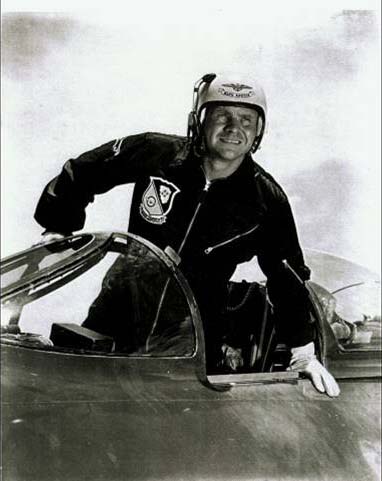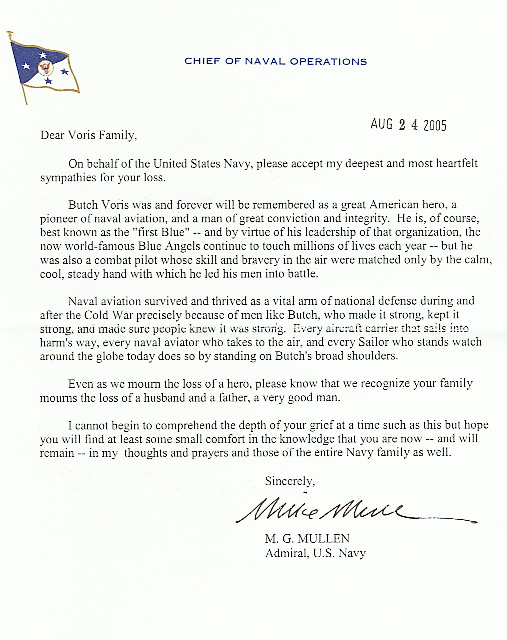Roy Marlin “Butch” Voris (1919-2005)
Capt. (Retired) Roy Marlin “Butch” Voris, creator of the famed Navy Blue Angels air demonstration team and a World War II flying ace from the Pacific War, died Tuesday at his home in Monterey, CA. Voris, 86, had been ill for several years but was still drawing huge crowds at air shows whenever he attended. The 2004 California Air Show at Salinas, CA had been dedicated in his honor.
A fighter pilot’s fighter pilot, he shared the pantheon with other American military aviation greats like Chuck Yeager, Gregory “Pappy” Boyington, and the “Right Stuff” astronauts, all of whom made their marks after Voris had helped pave the way. He himself had ended his active aviation career as a spokesman for NASA during the momentous 1970 moon shots.
 Physically a big man with a shaved head, Voris was known for his even-temperedness and coolness in the cockpit, as well as great skill. He had survived numerous accidents and emergency situations in the air, including a midair collision during a Blue Angel demonstration at Corpus Christi, TX, in 1952 in which one Blue Angel was killed and he miraculously brought his plane in despite lack of almost all control and a nearly severed tail. For all his accomplishments, he was unpretentious and had a humorous streak that kept him in demand as a speaker.
Physically a big man with a shaved head, Voris was known for his even-temperedness and coolness in the cockpit, as well as great skill. He had survived numerous accidents and emergency situations in the air, including a midair collision during a Blue Angel demonstration at Corpus Christi, TX, in 1952 in which one Blue Angel was killed and he miraculously brought his plane in despite lack of almost all control and a nearly severed tail. For all his accomplishments, he was unpretentious and had a humorous streak that kept him in demand as a speaker.
Voris’ career spanned 33 years. He had been instrumental in the early development of the F-14 “Tomcat,” one of the navy’s greatest fighter-bombers. He had flown everything from bi-planes to jets, most of them in combat. His status as ace was earned in the hard early years of the Pacific War when he shot down a confirmed eight (8) Japanese fighter planes. Flying from the carriers Enterprise and Hornet, he had taken part in the battles of Santa Cruz, Guadalcanal, Tarawa, numerous Central Pacific islands, the First Battle of the Philippine Sea, the Great Marianas Turkey Shoot, and “The Mission into Darkness,” in which air wing pilots had taken off near dusk to pursue the Japanese fleet knowing many probably wouldn’t have enough gas to return.
But Voris was most known for having forged in 1946 a handful of navy fighter pilots, veterans of the Pacific War, into the navy flight demonstration team that became known world-wide as the Blue Angels, today’s foremost ambassadors of American flight know-how and prowess. It was the first such official venture by any of the services. With the war over, the navy needed a recruiting tool and something that would help attract congressional dollars. Voris, back from the war and a Jacksonville Naval Air Station flight instructor, was given the job.
“My frame of mind was they didn’t offer this to me to come in second to the army,” he recalls in “First Blue,” a book published by St. Martins Press last year about his life. “I felt that if we weren’t the best, it would be my naval career.”
What he forged was the first of its kind: a show about 15 minutes long with three Hellcats, the fighters he’d flown mostly in the Pacific, roaring almost wingtip to wingtip in unison, doing rolls and maneuvers experienced often in dogfights but seldom ever seen by the public. The first show was a sensation, and by the end of the year, the team had found a name based on a New York nightclub and Butch had hand-picked leaders who would succeed him. His strong personality, insistence on excellence through pilot debriefs and commitment, and through teamwork, established a tradition that continues with the Blues today. At Salinas this past year, current as well as former Blues honored him at attention with a red carpet and salutes as he passed them by.
“I wouldn’t change a thing,” he’s quoted in First Blue. “I wish I could do it all over again.”

In 1952, Voris was brought back to reform the Blue’s following their stint as the nucleus of a fighter squadron in the Korean War. They had not performed for several years. As such he was one of only two Blue leaders ever to lead the group twice. This time he did it in Panther jets. Additionally, he was twice the skipper of fighter squadrons – VF-113 and VF-191 – and commanding officer of a carrier air group, CAG-5. After retiring from the navy as a captain in 1963, he went to work as an executive of Grumman Aircraft Corporation, Bethpage, New York – the company whose many airplanes he had flown and loved until 1973, when he joined NASA.
Moved by the sight of airplanes as a youngster, Voris, who was born in Los Angeles, was considering a career as a mortician after graduating from high school in Santa Cruz, CA and Salinas Junior College. He didn’t think he’d have enough money to learn to fly. Then he saw a recruiting poster and realized the navy might teach him for nothing. He was still finishing flight training when the Japanese bombed Pearl Harbor on December 7, 1941. Shipped out to war when things looked bleakest, he served in VF-10 “The Grim Reapers,” under Jimmy Flatley, and later, as the carriers began to take back the Pacific, with VF-2, “The Rippers,” commanded by Bill Dean. At one point, the Rippers had more aces than any other squadron in the Pacific.
He was awarded three Distinguished Flying Crosses, 11 air medals, and three Presidential Unit Citations and the Purple Heart received when he almost was killed by a Japanese Zero on his tail that shot up his cockpit as he defended Guadalcanal. He was in a less-maneuverable F4F Wildcat and figured it was over until he dove in a last-ditch maneuver and escaped. That was his first real dogfight.
Butch is a member of the Navy Aviation Hall of Fame in Pensacola, FL, and the International Air Show Hall of Fame. An aircraft bearing his name is outside Jacksonville Naval Air Station and the Passenger Terminal at the station is named for him. In 1993, he was honored by the air force in a “Gathering of Eagles” ceremony as one of 20 aviators worldwide who have made significant contributions to aviation. The gathering is an annual event. In 2003, his wife of over 50 years, Thea passed away. They had been married since 1947.
Butch is survived by daughters Randie and Jill, sons-in-law Hank and Joe, and grandsons Hank Jr., Ryan and Todd. In addition, he is survived by brothers Robert and Richard.
A memorial service was held on October 10, 2005 at Ford Ord Chapel in Seaside, CA.


